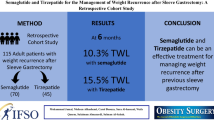Abstract
Background
The obesity surgery mortality risk score (OS-MRS) is a five-point scoring system stratifying the risk of post-operative mortality. Patients with a body mass index (BMI) > 60 may also carry an increased risk of peri-operative complications. Laparoscopic sleeve gastrectomy (LSG) as an initial procedure could reduce weight and associated comorbidity allowing a safer, definitive second procedure. We investigated weight loss and risk reduction in patients having LSG as part of a planned two-stage definitive bariatric procedure.
Methods
Patients with a high OS-MRS (4–5), males with BMI > 60 or females with BMI > 65, who underwent LSG were identified from a prospective database. Data were analysed by means of the Mann–Whitney U and Chi-squared test.
Results
Sixty-eight patients underwent LSG. LSG reduced median BMI at 12 months (68 versus 54, P < 0.001) and the OS-MRS (3 versus 2, P = 0.005). An increase in patients considered low risk (OS-MRS, 0–1) was seen following LSG (35% versus 14%, P = 0.006). The proportion of patients with BMI < 50 increased from 0% to 30% (P < 0.001). Improvement or resolution of diabetes and hypertension was seen in 23% and 25% of cases, respectively.
Conclusions
LSG achieves good weight loss, reduces the OS-MRS and improves obesity-related comorbidity in high-risk surgical patients.
Similar content being viewed by others
References
Karlsson J, Taft C, Ryden A, et al. Ten-year trends in health-related quality of life after surgical and conventional treatment for severe obesity: the SOS intervention study. Int J Obes Lond. 2007;31:1248–61.
Dresel A, Kuhn JA, McCarty TM. Laparoscopic Roux-en-Y gastric bypass in morbidly obese and super morbidly obese patients. Am J Surg. 2004;187:230–2. discussion 232.
Fernandez AZ Jr, Demaria EJ, Tichansky DS, et al. Multivariate analysis of risk factors for death following gastric bypass for treatment of morbid obesity. Ann Surg. 2004;239:698–702. discussion 702-693.
Ren CJ, Patterson E, Gagner M. Early results of laparoscopic biliopancreatic diversion with duodenal switch: a case series of 40 consecutive patients. Obes Surg. 2000;10:514–23. discussion 524.
DeMaria EJ, Murr M, Byrne TK, et al. Validation of the obesity surgery mortality risk score in a multicenter study proves it stratifies mortality risk in patients undergoing gastric bypass for morbid obesity. Ann Surg. 2007;246:578–82. discussion 583-574.
Fuks D, Verhaeghe P, Brehant O, et al. Results of laparoscopic sleeve gastrectomy: a prospective study in 135 patients with morbid obesity. Surgery. 2009;145:106–13.
Almogy G, Crookes PF, Anthone GJ. Longitudinal gastrectomy as a treatment for the high-risk super-obese patient. Obes Surg. 2004;14:492–7.
Langer FB, Reza Hoda MA, Bohdjalian A, et al. Sleeve gastrectomy and gastric banding: effects on plasma ghrelin levels. Obes Surg. 2005;15:1024–9.
Milone L, Strong V, Gagner M. Laparoscopic sleeve gastrectomy is superior to endoscopic intragastric balloon as a first stage procedure for super-obese patients (BMI > or =50). Obes Surg. 2005;15:612–7.
Mognol P, Chosidow D, Marmuse JP. Laparoscopic sleeve gastrectomy as an initial bariatric operation for high-risk patients: initial results in 10 patients. Obes Surg. 2005;15:1030–3.
Baltasar A, Serra C, Perez N, et al. Laparoscopic sleeve gastrectomy: a multi-purpose bariatric operation. Obes Surg. 2005;15:1124–8.
Tichansky DS, DeMaria EJ, Fernandez AZ, et al. Postoperative complications are not increased in super-super obese patients who undergo laparoscopic Roux-en-Y gastric bypass. Surg Endosc. 2005;19:939–41.
Abeles D, Kim JJ, Tarnoff ME, et al. Primary laparoscopic gastric bypass can be performed safely in patients with BMI > or = 60. J Am Coll Surg. 2009;208:236–40.
DeMaria EJ, Portenier D, Wolfe L. Obesity surgery mortality risk score: proposal for a clinically useful score to predict mortality risk in patients undergoing gastric bypass. Surg Obes Relat Dis. 2007;3:134–40.
Cohen R, Uzzan B, Bihan H, et al. Ghrelin levels and sleeve gastrectomy in super-super-obesity. Obes Surg. 2005;15:1501–2.
Conflict of interest
The authors declare they have no conflict of interest.
Author information
Authors and Affiliations
Corresponding author
Rights and permissions
About this article
Cite this article
Magee, C.J., Barry, J., Arumugasamy, M. et al. Laparoscopic Sleeve Gastrectomy for High-Risk Patients: Weight Loss and Comorbidity Improvement—Short-Term Results. OBES SURG 21, 547–550 (2011). https://doi.org/10.1007/s11695-010-0226-8
Published:
Issue Date:
DOI: https://doi.org/10.1007/s11695-010-0226-8




